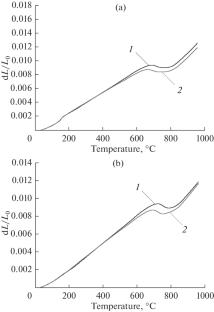控制奥氏体相变钢运行过程中α→γ转变温度随其结构相状态的变化
IF 0.3
Q4 MATERIALS SCIENCE, MULTIDISCIPLINARY
引用次数: 0
摘要
确定了5G4N3Kh2M2FSTB模具钢α→γ转变的临界温度随其初始状态(不同固溶体饱和度)的变化。研究发现,在低加热速率下(2 K/min),固溶体饱和度的降低导致温度AC1的升高。在较高的加热速率(10 K/min)下观察到相反的效果。本文章由计算机程序翻译,如有差异,请以英文原文为准。

Variation of α → γ Transformation Temperatures in Steel with Controlled Austenitic Transformation during Operation, Depending on Its Structural–Phase State
The critical temperatures of the α → γ transformation in 5G4N3Kh2M2FSTB die steel depending on its initial state (different levels of saturation of the solid solution) are determined. It is found that, at low rates of heating (2 K/min), the decrease in the level of saturation of the solid solution results in an increase in temperature AC1. An opposite effect is observed at higher rates of heating (10 K/min).
求助全文
通过发布文献求助,成功后即可免费获取论文全文。
去求助
来源期刊

Inorganic Materials: Applied Research
Engineering-Engineering (all)
CiteScore
0.90
自引率
0.00%
发文量
199
期刊介绍:
Inorganic Materials: Applied Research contains translations of research articles devoted to applied aspects of inorganic materials. Best articles are selected from four Russian periodicals: Materialovedenie, Perspektivnye Materialy, Fizika i Khimiya Obrabotki Materialov, and Voprosy Materialovedeniya and translated into English. The journal reports recent achievements in materials science: physical and chemical bases of materials science; effects of synergism in composite materials; computer simulations; creation of new materials (including carbon-based materials and ceramics, semiconductors, superconductors, composite materials, polymers, materials for nuclear engineering, materials for aircraft and space engineering, materials for quantum electronics, materials for electronics and optoelectronics, materials for nuclear and thermonuclear power engineering, radiation-hardened materials, materials for use in medicine, etc.); analytical techniques; structure–property relationships; nanostructures and nanotechnologies; advanced technologies; use of hydrogen in structural materials; and economic and environmental issues. The journal also considers engineering issues of materials processing with plasma, high-gradient crystallization, laser technology, and ultrasonic technology. Currently the journal does not accept direct submissions, but submissions to one of the source journals is possible.
 求助内容:
求助内容: 应助结果提醒方式:
应助结果提醒方式:


